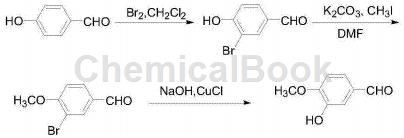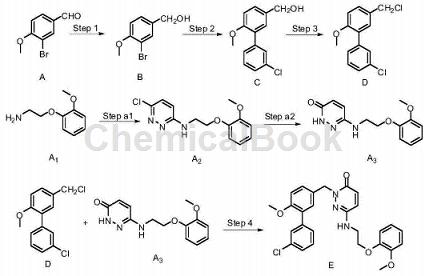Background and Overview
3-Bromo-4-methoxybenzaldehyde is a pharmaceutical intermediate that can be used to prepare isovillin and clobiopram.
Apply [1-2]
1. Used in the preparation of isovillin
Isovanillin is also known as isovillyl aldehyde, also known as isovillyl aldehyde. Its chemical name is 3-hydroxy-4-methoxybenzaldehyde. It is a white or light yellow crystalline powder or needle crystal, with a melting point of 116~117°C. , with a boiling point of 179°C, has the aroma of vanilla beans and a rich milky aroma. It is an indispensable and important raw material in the food additive industry. It can be used as a spice, flavor, food and cosmetic additive, and is also used as a plant growth regulator and drug intermediate. body. CN201710330196.4 provides a new synthesis process of isovillin with cheap and easy raw materials, high product yield in each step, and simple operation, which is suitable for industrial production. The technical problems to be solved by the present invention are realized by the following technical solutions: a new synthesis process of isovillin, using 4-hydroxybenzaldehyde as raw material, first reacting with bromine to obtain 3-bromo-4-hydroxybenzaldehyde, Then react with methyl iodide to obtain 3-bromo-4-methoxybenzaldehyde, and then hydrolyze it under the action of sodium hydroxide and cuprous chloride to obtain isovillin.
A new synthesis process of isovillin, including the following steps:
(1) Add solvent to the reaction vessel, then add 4-hydroxybenzaldehyde, control the temperature and add bromine dropwise. After the dropwise addition is completed, keep the reaction warm. Stop the reaction after the reaction of the raw materials in the central control is complete. Add water to quench the reaction. Extraction, concentration and recrystallization yield 3-bromo-4-hydroxybenzaldehyde;
(2) Put 3-bromo-4-hydroxybenzaldehyde into the reaction vessel, then put in the solvent and inorganic base, control the temperature and dropwise add methyl iodide, control the reaction of the raw materials after the reaction is complete, concentrate the reaction solution, and add the concentrated residue In ice water, a solid precipitated and was recrystallized to obtain 3-bromo-4-methoxybenzaldehyde;
(3) Put 3-bromo-4-methoxybenzaldehyde into the reaction vessel, then put in 30% liquid alkali, catalyst and phase transfer catalyst, control the reaction temperature, after the reaction of the central control raw materials is complete, filter and adjust acid, a solid precipitates, and the product isovanillin is obtained by recrystallization.
The specific synthesis route is as follows:

2. Used to prepare clobiopram, a PDE4 inhibitor
Phosphodiesterase 4 (PDE4) is closely related to the functions of the central nervous system and immune system, and its inhibitors are considered to be new anti-inflammatory drugs and central nervous system drug candidates that act on intracellular targets. The first-generation PDE4 inhibitors such as rolipram have good antidepressant effects. The reason why they cannot be marketed is the side effects such as nausea and vomiting caused by inhibiting PDE4. Compared with the first-generation PDE4 inhibitors, the second-generation PDE4 inhibitors have better therapeutic effects, but so far there is no PDE4 inhibitor that can prevent vomiting on the market. CN201611164170.9 discloses a method for preparing the PDE4 inhibitor clobiopram. Experiments have shown that the yield of this method is as high as 71%. The synthetic route of this preparation method is:

Includes the following steps:
(1) Using 3-bromo-4-methoxybenzaldehyde as the starting material A, the reduction reaction generates compound B, which is 3-bromo-4-methoxybenzyl alcohol;
(2) Perform Suzuki reaction between compound B and m-chlorophenylboronic acid under the catalysis of palladium salt catalyst to generate compound C;
(3) Chloride compound C with a chlorinating reagent to generate compound D;
(4) The raw material compound A1 and 3,6-dichloropyridazine are heated to reflux reaction to generate compound A2; compound A2 and sodium acetate are heated to reflux reaction to generate compound A3;
(5) Compound D and compound A3 are refluxed under alkaline conditions to generate the target product E, chlorbiopram.
Compared with the existing technology, the preparation method of the present invention has the following advantages: the yield is as high as 64-71%, which is 42.2%-57.8% higher than the previous synthesis method, the raw materials are easy to obtain and cheap, and the reaction conditions are mild , has low equipment requirements and can achieve industrialized production. The invention provides an efficient and easy new way for the synthesis of clobiopram.
Main reference materials
[1] CN201710330196.4 A new synthesis process of isovillin
[2] CN201611164170.9 Preparation method of PDE4 inhibitor clobiopram


